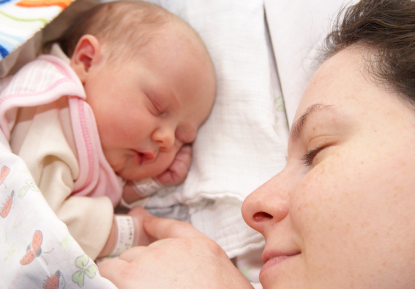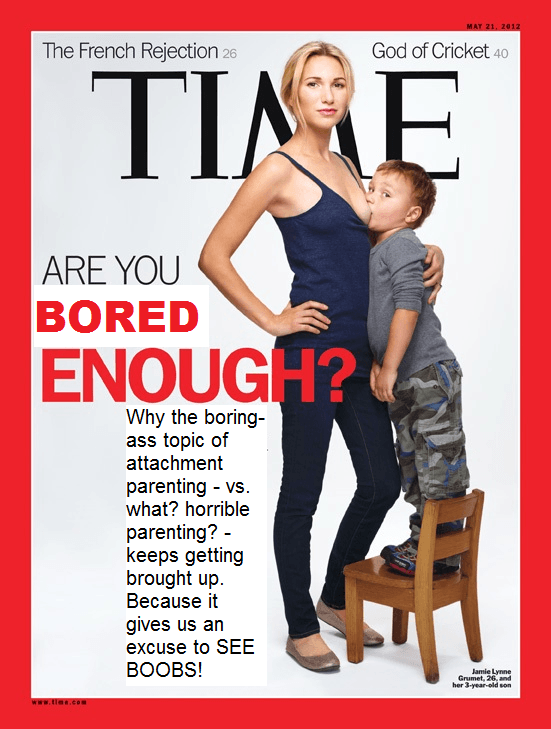A few weeks ago, the City of Milwaukee launched a provocative ad campaign warning parents of the dangers of babies sleeping in adult beds. The ad depicts a baby sleeping in an adult bed, surrounded by puffy pillows and blankets, with a large knife is tucked in the covers nearby. The headline reads, “Your baby sleeping with you can be just as dangerous. Babies can die when sleeping in adult beds. Always put your baby to sleep on his back, in a crib. If you can’t afford a crib, call (414) 286-8620.”
Not surprisingly, this ad caused a huge stir. Personally, I kind of rolled my eyes and went on with my day, since I’ve happily and safely slept with all my three babies in my bed (currently sleeping with my 19-month old). What’s the big deal? I know that when done in safe manner, co-sleeping can actually be more beneficial for your baby than sleeping alone in a crib can be.

image from Babyphotos.co.in
Not that I think we should ignore the safety of the world’s babies. The men who unveiled the campaign, Mayor Tom Barrett and Commissioner of Health Bevan Baker, have the admirable goal of trying to reduce the city’s sky-high African-American infant mortality rate by 15% by 2017. At least nine children have died this year in Milwaukee in an unsafe sleep environment. But is scaring responsible parents away from co-sleeping really the answer?
I would say no. For the record, there is no correlation between co-sleeping and SIDS. I’m with Dr. Sears, who states:
Every night millions of mothers and babies the world over sleep close to each other, and the babies wake up just fine. Instead of alarming conscientious parents, like the recent shocking and insensitive ad campaign in Milwaukee did, as reported in the Journal Sentinel, sleep advisors should be teaching parents how to co-sleep safely.
You can check out this article by Dr. Sears for the “show-me-the-science” proof, but from my own experiences I can say that throughout the night, however deeply I may be sleeping, I am always aware of my baby. And not just the baby in my bed, but even my kids in the other room… I wake at the slightest movement. It’s like I’m subconsciously wired to jump out of bed at the tiniest rustle or whimper.
Or, as Dr. Sears puts it: “Mothers enjoy a heightened awareness of their baby’s presence, what I call a “nighttime sleep harmony,” that protects baby. The co-sleeping mother is more aware if her baby’s well-being is in danger.”
Despite being easily and frequently awakened, I think my babies and I get a good night’s sleep together. I nurse them “on demand” and we enjoy each other’s warmth and closeness. I know that this is not the most comfortable situation for every mother, but for me and my babies, it’s what works. And I know my babies feel the same way, because our older kids still love jumping into bed with us (although it gets a bit squishy with all those elbows and knees)!
Says Dr. Sears: “Research shows that co-sleeping infants cry less during the night, compared to solo sleepers who startle repeatedly throughout the night and spend 4 times the number of minutes crying. Startling and crying releases adrenaline, which can interfere with restful sleep and leads to long term sleep anxiety.”
And less crying and anxiety (I know I feel anxious when my babies cry, especially in middle of the night!) is obviously beneficial for everyone involved! Then there are the extended health benefits of breastfeeding for babies and moms. Plus the research showing that “infants who sleep near to parents have more stable temperatures, regular heart rhythms, and fewer long pauses in breathing compared to babies who sleep alone.”
I should point out that Dr. Sears defines co-sleeping not as bed-sharing, but as “sleeping close enough to baby for easy comforting.” This could be in a crib in your room or a bedside sleeper. But for now, I’ll keep my babies in my bed, thank you very much!
So, how to do it safely? Here are Dr. Sears‘ guidelines:
- We recommend using a bassinet that attaches safely and securely to parents’ bed, which allows both mother and baby to have their own sleeping space, while baby still enjoys sleeping close to mommy for easier feeding and comforting.
- If bed-sharing, practice these safe precautions:
- Place babies to sleep on their backs.
- Be sure there are no crevices between the mattress and guardrail or headboard that allows baby’s head to sink into.
- Do not allow anyone but mother to sleep next to the baby, since only mothers have that protective awareness of baby. Place baby between mother and a guardrail, not between mother and father. Father should sleep on the other side of mother.
- Don’t fall asleep with baby on a cushy surface, such as a beanbag, couch, or wavy waterbed.
- Don’t bed-share if you smoke or are under the influence of drugs, alcohol, or medications that affect your sleep.
Dr. Sears concludes:
We have enjoyed sleeping close to our own babies. I have promoted safe co-sleeping in our pediatric practice for nearly 40 years and have witnessed only positive outcomes, such as: babies sleep and grow better; promotes better bonding; breastfeeding is easier; and infants grow up with a healthy sleep attitude, regarding sleep as a pleasant state to enter and a fearless state to remain in.
Because I highly value safe sleeping arrangements, I have thoroughly researched this subject. If you wish to read my research references that go into co-sleeping and bed-sharing in scientific detail, as well as more practical and safe nighttime parenting practices, consult the following:
Scientific Benefits of Co-Sleeping
Safe Co-sleeping Habits
7 Benefits of Sleeping Close to Your Baby
Co-Sleeping: Yes, No, Sometimes?
As well as our books, which can be ordered here.
Happy co-sleeping!




